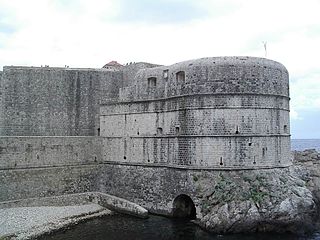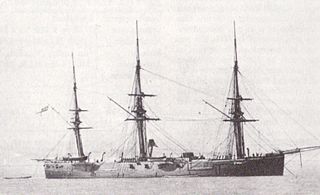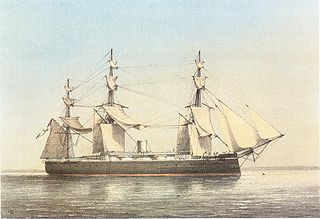
A broadside is the side of a ship, the battery of cannon on one side of a warship; or their coordinated fire in naval warfare. From the 16th century until the early decades of the steamship, vessels had rows of guns set in each side of the hull. Firing all guns on one side of the ship became known as a "broadside". The cannons of 18th-century men of war were accurate only at short range, and their penetrating power mediocre, entailing that the thick hulls of wooden ships could only be pierced at short ranges. These wooden ships sailed closer and closer towards each other until cannon fire would be effective. Each tried to be the first to fire a broadside, often giving one party a decisive headstart in the battle when it crippled the other ship.

An ironclad is a steam-propelled warship protected by iron or steel armor plates used in the early part of the second half of the 19th century. The ironclad was developed as a result of the vulnerability of wooden warships to explosive or incendiary shells. The first ironclad battleship, Gloire, was launched by the French Navy in November 1859. The British Admiralty had been considering armored warships since 1856 and prepared a draft design for an armored corvette in 1857; in early 1859 the Royal Navy started building two iron-hulled armored frigates, and by 1861 had made the decision to move to an all-armored battle fleet. After the first clashes of ironclads took place in 1862 during the American Civil War, it became clear that the ironclad had replaced the unarmored ship of the line as the most powerful warship afloat. This type of ship would come to be very successful in the American Civil War.

A warship or combatant ship is a naval ship that is built and primarily intended for naval warfare. Usually they belong to the armed forces of a state. As well as being armed, warships are designed to withstand damage and are usually faster and more manoeuvrable than merchant ships. Unlike a merchant ship, which carries cargo, a warship typically carries only weapons, ammunition and supplies for its crew. Warships usually belong to a navy, though they have also been operated by individuals, cooperatives and corporations.

Steam frigates, also known as screw frigates and the smaller steam corvettes and steam sloops were steam-powered warships that were not meant to stand in the line of battle. The first such ships were paddle steamers. Later on the invention of screw propulsion enabled construction of steam-powered versions of the traditional frigates, corvettes, and sloops.

Turret ships were a 19th-century type of warship, the earliest to have their guns mounted in a revolving gun turret, instead of a broadside arrangement.

Barbettes are several types of gun emplacement in terrestrial fortifications or on naval ships.

Pre-dreadnought battleships were sea-going battleships built between the mid- to late 1880s and 1905, before the launch of HMS Dreadnought. Pre-dreadnoughts replaced the ironclad battleships of the 1870s and 1880s. Built from steel, and protected by hardened steel armour, pre-dreadnought battleships carried a main battery of very heavy guns in barbettes supported by one or more secondary batteries of lighter weapons. They were powered by coal-fuelled triple-expansion steam engines.

A casemate is a fortified gun emplacement or armored structure from which guns are fired. Originally, the term referred to a vaulted chamber in a fortress. In armoured fighting vehicles that do not have a turret for the main gun, the structure that accommodates the gun is termed the casemate.

A gun turret is a location from which weapons can be fired that affords protection, visibility, and some cone of fire. A modern gun turret is generally a weapon mount that houses the crew or mechanism of a projectile-firing weapon and at the same time lets the weapon be aimed and fired in some degree of azimuth and elevation.

The Prince Consort class of battleship were four Royal Navy wooden-hulled broadside ironclads: HMS Royal Oak, HMS Prince Consort, HMS Ocean, and HMS Caledonia. They were originally laid down as Bulwark-class battleships, but were converted to ironclads. Royal Oak was Britain's fifth ironclad battleship completed.

HMS Research was a small ironclad warship, converted from a wooden-hulled sloop and intended as an experimental platform in which to try out new concepts in armament and in armour. She was launched in 1863, laid up in 1878 and sold for breaking in 1884, having displayed serious limitations as a warship.

HMS Favorite was one of the three wooden warships of moderate dimension selected by Sir Edward Reed for conversion to broadside ironclads in response to the increased tempo of French warship building.

HMS Pallas was a purpose-built wooden-hulled ironclad of the Royal Navy, designed as a private venture by Sir Edward Reed, and accepted by the Board of Admiralty because, as an economy measure, they wished to use up the stocks of seasoned timber held in the Woolwich Dockyard. The fact that Woolwich was not equipped to build iron ships was also relevant.
HMS Repulse was the last wooden battleship constructed for the Royal Navy.

HMS Monarch was the first seagoing British warship to carry her guns in turrets, and the first British warship to carry guns of 12-inch (300 mm) calibre.

HMS Alexandra was a central battery ironclad of the Victorian Royal Navy, whose seagoing career was from 1877 to 1900. She spent much of her career as a flagship, and took part in operations to deter Russian aggression against Turkey in 1878 and the bombardment of Alexandria in 1882.

The casemate ironclad is a type of iron or iron-armored gunboat briefly used in the American Civil War by both the Confederate States Navy and its adversary, the Union Navy. Compared to the turreted ironclad warships that became standard, the casemate ironclad does not have its individual cannons encased in a separate armored gun deck/turret, but instead has a single casemate structure, or armored citadel, on the main deck housing the entire gun battery. As the guns are carried on the top of the ship yet still fire through fixed gunports, the casemate ironclad is seen as an intermediate stage between the traditional broadside frigate and the modern warships.

The central battery ship, also known as a centre battery ship in the United Kingdom and as a casemate ship in European continental navies, was a development of the (high-freeboard) broadside ironclad of the 1860s, given a substantial boost due to the inspiration gained from the Battle of Hampton Roads, the very first battle between ironclads fought in 1862 during the American Civil War. One of the participants was the Confederate casemate ironclad CSS Virginia, essentially a central battery ship herself, albeit a low-freeboard one. The central battery ships had their main guns concentrated in the middle of the ship in an armoured citadel. The concentration of armament amidships meant the ship could be shorter and handier than a broadside type like previous warships. In this manner the design could maximize the thickness of armour in a limited area while still carrying a significant broadside. These ships meant the end of the armoured frigates with their full-length gun decks.

A gunport is an opening in the side of the hull of a ship, above the waterline, which allows the muzzle of artillery pieces mounted on the gun deck to fire outside. The origin of this technology is not precisely known, but can be traced back to the late 15th century, with the appearance of artillery in naval warfare. Ships featuring gunports were said to be pierced, since the ports were cut through the hull after the construction.





















